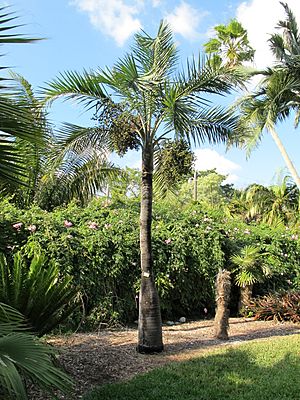Florida cherry palm facts for kids
Quick facts for kids Florida cherry palm |
|
|---|---|
 |
|
| Conservation status | |
| Scientific classification | |
| Genus: |
Pseudophoenix
|
| Species: |
sargentii
|
The Florida cherry palm (Pseudophoenix sargentii), also known as the buccaneer palm, is a cool medium-sized palm. You can find it growing naturally in the northern Caribbean islands, eastern Mexico, and the very southeastern part of Florida in the United States. This palm is special because it's considered vulnerable, meaning it needs our help to survive in the wild.
Contents
What Does the Florida Cherry Palm Look Like?
The Florida cherry palm usually grows near the sea. It likes sandy or limestone soils. Its trunk grows in rings, reaching up to 8 meters (about 26 feet) tall. The trunk can be up to 30 centimeters (about 1 foot) wide. Sometimes, the trunk looks a bit swollen. This palm also has yellowish flowers. They grow in loose groups.
Protecting the Florida Cherry Palm
Scientists think this palm might be safe in most places. But they don't have much information about how many there are worldwide. In Florida, this palm is in big trouble. It is considered critically endangered there. This means it's very close to disappearing from Florida forever.
Historically, this palm was found only on three Florida Keys: Elliott Key, Long Key, and Sands Key. A large group of these palms from Long Key was destroyed in the early 1900s. People dug them up and sold them as garden plants. Today, the only natural group left in Florida is on Elliott Key. It has fewer than 50 individual palms. The IUCN lists this palm as a Vulnerable species. This means it faces a high risk of becoming extinct in the wild.
Growing the Florida Cherry Palm
The Florida cherry palm is a very attractive palm. People grow it for its beauty in special horticulture gardens. It is also available as an ornamental palm for private gardens. You might also see it in habitat gardens. It is used in projects that focus on sustainable landscaping and restoring natural areas.
See also
In Spanish: Pseudophoenix sargentii para niños


